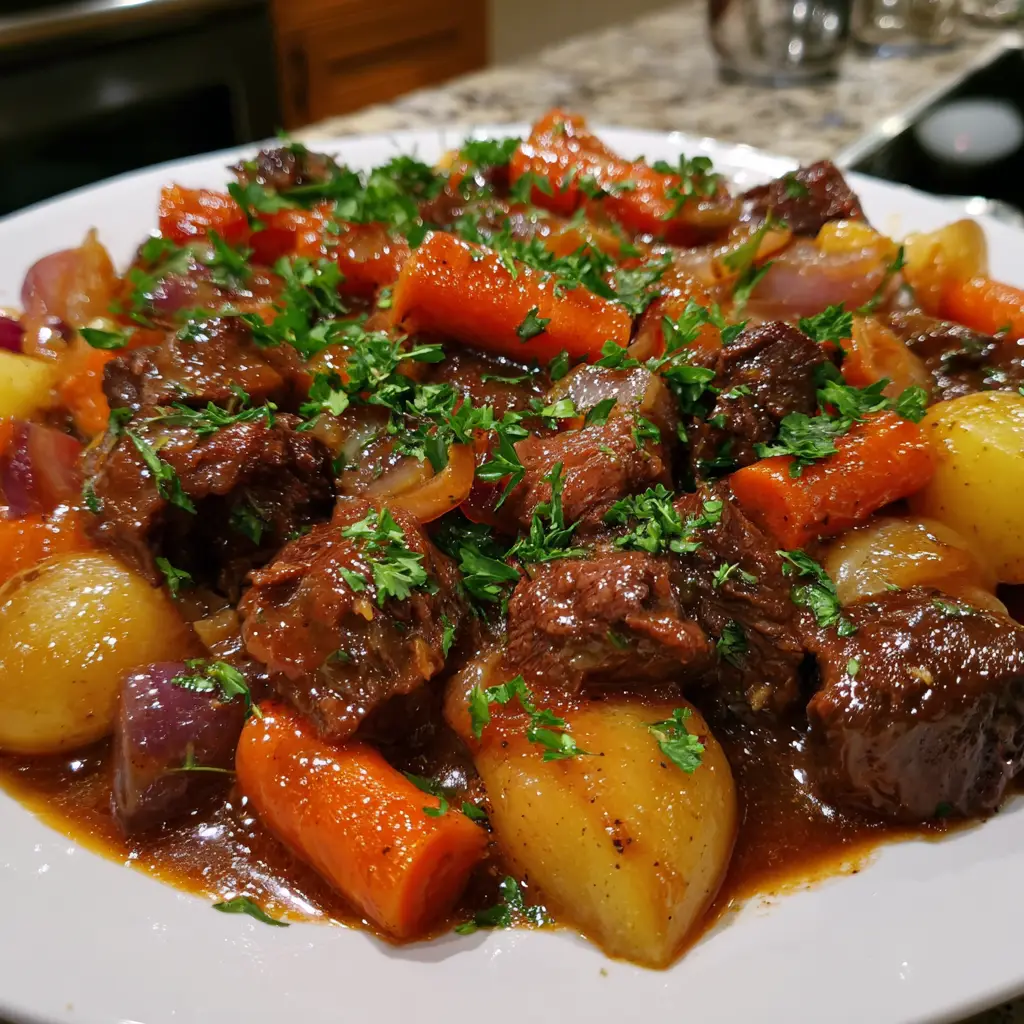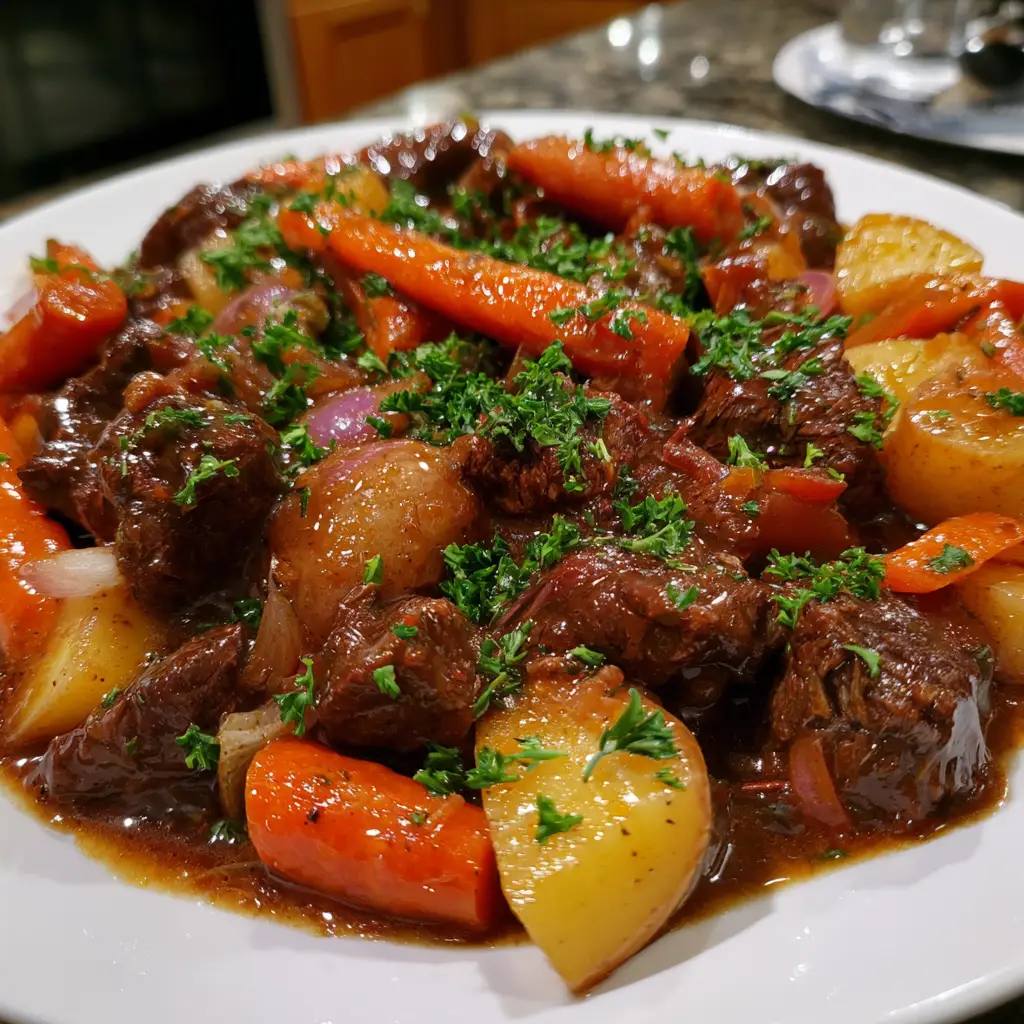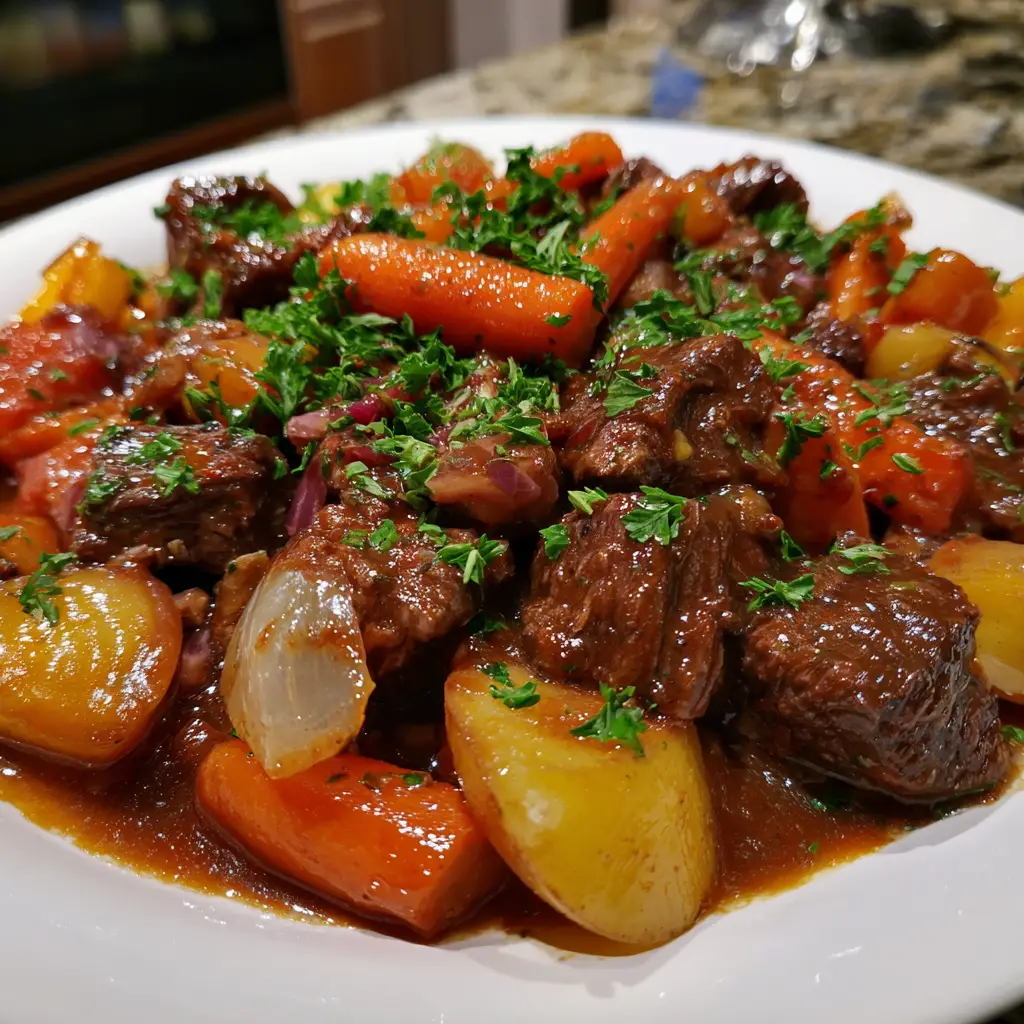Classic Beef Stew is the undisputed monarch of comfort food, a culinary touchstone that has warmed hearts and filled bellies across generations and cultures. This is not merely a soup; it is a hearty, robust, and complete meal simmered slowly in a single pot, where humble, inexpensive ingredients are transformed into something extraordinarily sublime. The very essence of this dish lies in its patient, slow-cooking process, which coaxes out the deep, savory flavors locked within a tough cut of beef, tenderizing it until it yields effortlessly to a fork, melting in your mouth like butter.
Why Is This Classic Beef Stew So Popular?
The universal and enduring popularity of Classic Beef Stew is built upon a foundation of practicality, profound flavor, and emotional resonance. Firstly, it is an economical powerhouse, designed to transform an affordable, tough cut of meat into a luxurious and satisfying feast. This makes it a staple in households worldwide, a symbol of resourceful and intelligent cooking. Secondly, it is the ultimate “one-pot wonder,” minimizing cleanup and maximizing efficiency, which appeals to both busy weeknight cooks and leisurely weekend chefs.
Its versatility is another key to its fame; it is a canvas for creativity, welcoming a variety of root vegetables, herbs, and even a splash of red wine, allowing each cook to imprint their personal signature on the classic template. Furthermore, it is a dish that actually improves with time. The flavors continue to develop and meld as it sits, making the leftovers often more coveted than the initial serving. Beyond its practical virtues, beef stew holds a deep, nostalgic power. The aroma that fills a home as it simmers is universally recognized and loved, evoking feelings of security, family gatherings, and unconditional comfort. It is a dish that nourishes not just the body, but also the spirit.
Why You’ll Love This Classic Beef Stew:
You will develop a deep and abiding love for this specific Classic Beef Stew recipe because it is meticulously crafted to guide you toward the most flavorful, tender, and authentic result possible. You will love the emphasis on the crucial first step of properly searing the beef, creating a dark, caramelized crust (the “fond”) on the bottom of the pot that forms the irreplaceable flavor foundation for the entire stew. You will appreciate the detailed explanation of creating a rich roux and deglazing with a full-bodied red wine, techniques that build layers of complexity and body into the broth, setting it miles apart from thin or bland versions.
This recipe champions the use of tomato paste cooked until it deepens in color, a chef’s secret that adds a subtle umami richness and beautiful color. You will adore the guidance on when to add each vegetable to ensure they are all perfectly cooked, tender but not mushy, and the inclusion of pearl onions for their sweet, elegant finish. This stew is also a practical dream; it is perfectly suited for both the stovetop and the oven, it freezes magnificently for future effortless meals, and it fills your home with an aroma that is nothing short of magical. Most importantly, you will love the unparalleled sense of satisfaction that comes from serving a bowl of this hearty, homemade masterpiece, a dish that communicates care, tradition, and pure culinary love.
Here’s what you’ll need:
The Beef & Aromatics:
-
3-4 pounds Beef Chuck Roast, trimmed and cut into 1.5-inch cubes: Chuck is the ideal cut, as its marbling of fat and connective tissue breaks down during slow cooking, becoming incredibly tender and flavorful.
-
3 tablespoons Olive Oil or Vegetable Oil: For searing the beef.
-
1 large Yellow Onion, roughly chopped: Provides a sweet, savory base.
-
4 cloves Garlic, minced: For essential aromatic depth.
-
3 tablespoons Tomato Paste: For richness, color, and umami.
-
⅓ cup All-Purpose Flour: For dredging the beef and thickening the stew.
-
Kosher Salt and Freshly Cracked Black Pepper: For seasoning throughout.
The Braising Liquids & Herbs:
-
1 cup Dry Red Wine (such as Cabernet Sauvignon, Merlot, or Pinot Noir): Adds acidity and deep, complex fruit notes. The alcohol cooks off, leaving only flavor.
-
4 cups Beef Broth, preferably low-sodium: The primary braising liquid. Using low-sodium allows you to control the final salt level.
-
2 cups Water: To ensure the meat is fully submerged.
-
2 Bay Leaves: A classic stewing herb for aromatic depth.
-
1 tablespoon Fresh Thyme leaves (or 1 teaspoon dried): Earthy and floral.
-
1 teaspoon Fresh Rosemary, finely chopped (or ½ teaspoon dried): Pungent and piney.
The Vegetables:
-
1 pound Carrots, peeled and cut into 1-inch chunks: They become sweet and tender.
-
1.5 pounds Yukon Gold Potatoes, peeled and cut into 1.5-inch chunks: Their buttery texture and waxy nature hold their shape beautifully.
-
2 Celery Stalks, cut into ½-inch slices: Adds an earthy, slightly bitter note.
-
1 cup Frozen Pearl Onions, thawed: A classic, elegant touch that provides a pop of sweetness. Fresh pearl onions, peeled, can also be used.
-
1 cup Frozen Peas, thawed: Added at the very end for a burst of color and sweet freshness.
The Optional Finishing Touch:
-
2 tablespoons Unsalted Butter, softened: Swirled in at the end to add a final layer of richness and a glossy sheen to the gravy.
How to Make Classic Beef Stew:
Now that you have your ingredients ready, let’s dive into the steps for making this delightful Classic Beef Stew. It’s as easy as pie, and I promise you’ll feel like a culinary superstar!
Step 1: Dredge and Sear the Beef (The Flavor Foundation)
Pat the beef chuck cubes completely dry with paper towels—this is the single most important step for achieving a proper sear, not a steam. Season generously with salt and pepper. In a large, heavy-bottomed Dutch oven, heat 2 tablespoons of oil over medium-high heat until shimmering. Dredge the beef cubes in the flour, shaking off any excess. Working in batches to avoid overcrowding, sear the beef on all sides until a deep, dark brown crust forms, about 2-3 minutes per side. Transfer the seared beef to a plate and set aside.
Step 2: Sauté the Aromatics
Reduce the heat to medium. Add the remaining tablespoon of oil to the pot, then add the chopped onion and celery. Sauté for 5-6 minutes, until softened and translucent. Add the minced garlic and cook for one more minute until fragrant. Push the vegetables to the side and add the tomato paste to the cleared space. Cook the paste for 1-2 minutes, stirring, until it darkens slightly and becomes fragrant. This “toasting” deepens its flavor significantly.
Step 3: Deglaze with Red Wine
Pour the red wine into the pot, using a wooden spoon to scrape up all the browned bits (the “fond”) from the bottom. This is where the foundational flavor lies. Allow the wine to simmer and reduce by about half, which will take 3-4 minutes. This cooks off the raw alcohol taste and concentrates the flavor.
Step 4: Combine and Simmer
Add the seared beef back into the pot, along with any accumulated juices. Pour in the beef broth and water. Add the bay leaves, thyme, and rosemary. Bring the stew to a simmer, then immediately reduce the heat to low. Cover the pot with a lid slightly ajar and let it simmer gently for 1.5 to 2 hours. The beef should be starting to become tender but not yet fall-apart.
Step 5: Add the Root Vegetables
After the initial 1.5-2 hour simmer, add the chunked carrots and potatoes to the pot. Stir to submerge them in the liquid. Return the lid and continue to simmer for another 45 minutes to 1 hour, or until both the beef and the vegetables are fork-tender.
Step 6: Add the Finishing Vegetables
About 10 minutes before the end of the cooking time, stir in the thawed pearl onions. In the last 2 minutes of cooking, stir in the frozen peas just to heat them through. This preserves their bright color and texture.
Step 7: Final Adjustments and Serve
Remove the pot from the heat. Discard the bay leaves. For an extra-rich and glossy gravy, swirl in the 2 tablespoons of softened butter. Taste the stew and adjust the seasoning with more salt and pepper as needed. Let the stew rest, off the heat, for 10-15 minutes before serving; this allows the flavors to settle and the stew to thicken slightly.
Tips for Success:
-
Pat the Beef Dry: Never skip this step. Moisture is the enemy of browning.
-
Don’t Crowd the Pot: Searing in batches is essential. Overcrowding creates steam and prevents the Maillard reaction that creates the flavorful crust.
-
Low and Slow Simmer: A gentle simmer is key. A rolling boil will make the beef tough and cause the vegetables to disintegrate.
-
Skim the Fat: For a cleaner stew, after the first hour of simmering, you can use a spoon to skim off any excess fat that has risen to the surface.
-
Thickness Control: If you prefer a thicker stew, you can create a beurre manié by mashing equal parts soft butter and flour into a paste. Whisk small bits of this into the simmering stew until it reaches your desired consistency.
-
Taste at the End: Always do your final seasoning at the very end, as the flavors concentrate during cooking.
Equipment Needed:
-
Large (6-8 quart) Dutch Oven or Heavy-Bottomed Stockpot
-
Tongs
-
Wooden Spoon
-
Sharp Chef’s Knife
-
Cutting Board
-
Measuring Cups and Spoons
Variations of Classic Beef Stew:
-
Slow Cooker Beef Stew: Complete Steps 1-3 on the stovetop. Transfer the seared beef, sautéed aromatics, and deglazing liquid to your slow cooker. Add the broth, water, and herbs. Cook on LOW for 7-8 hours or HIGH for 4-5 hours. Add the carrots, potatoes, and pearl onions in the last 2 hours of cooking. Add the peas in the last 10 minutes.
-
Guinness Beef Stew: Substitute the red wine with 1 cup of Guinness or another stout beer for a deeply malty, bitter-complex flavor profile.
-
French-Inspired Beef Bourguignon: Use a full bottle of red Burgundy wine, add 8 ounces of sautéed bacon lardons, and include 1 pound of sautéed mushrooms.
-
Hearty Vegetable Addition: Add 1 cup of chopped parsnips or turnips along with the carrots for a more complex root vegetable flavor.
-
Mushroom Beef Stew: Add 8 ounces of sliced cremini mushrooms, sautéed until brown, along with the pearl onions.
Serving Suggestions for Classic Beef Stew:
This stew is a complete meal, but the right accompaniments make it a feast.
-
The Perfect Bread: A thick, crusty slice of Sourdough Bread or a warm Dinner Roll is mandatory for sopping up every last drop of the rich gravy.
-
Over Grains: Serve the stew over a bed of Buttered Egg Noodles, Fluffy Mashed Potatoes, or Creamy Polenta to stretch it further and add another textural element.
-
A Crisp Salad: A simple Mixed Green Salad with a sharp vinaigrette provides a refreshing, acidic contrast to the rich, hearty stew.
-
A Robust Beverage: Pair with the same dry red wine used in the stew, a dark ale, or a robust black tea.
Prep Time:
30 minutes
Cooking Time:
3 hours
Total Time:
3 hours 30 minutes
Nutritional Information (Estimated per serving, serves 6-8):
-
Calories: ~520
-
Protein: ~45g
-
Sodium: ~800mg
-
Sugar: ~9g
-
Fat: ~22g (Saturated Fat: ~8g)
-
Carbohydrates: ~35g
-
Fiber: ~6g
Please note: Nutritional information is an estimate and can vary significantly based on the specific brands of ingredients you use and the cut of beef.
FAQs about Classic Beef Stew:
Q: Can I make this stew ahead of time?
A: Absolutely. In fact, it’s highly recommended. Stew tastes even better the next day after the flavors have had time to meld. Cool it completely and store it in an airtight container in the refrigerator for up to 4 days. Reheat gently on the stovetop.
Q: Can I freeze Classic Beef Stew?
A: Yes, it freezes exceptionally well. Cool completely and store in freezer-safe containers for up to 3 months. The texture of the potatoes may become slightly softer upon thawing, but the flavor will be excellent. Thaw in the refrigerator overnight before reheating.
Q: My stew is too thin. How can I thicken it?
A: The easiest method is a cornstarch slurry. Mix 2 tablespoons of cornstarch with 3 tablespoons of cold water until smooth. Stir this into the simmering stew and cook for 2-3 minutes until thickened. Alternatively, use the beurre manié method described in the tips.
Q: My stew is too thick. How can I thin it?
A: Simply stir in additional beef broth or water, a half-cup at a time, until it reaches your desired consistency.
Q: What can I use instead of wine?
A: You can omit the wine and use an additional cup of beef broth. For complexity, add a tablespoon of balsamic vinegar or red wine vinegar along with the broth.
Final Thoughts:
Classic Beef Stew is more than just a recipe; it is a culinary ritual, a patient and rewarding process that yields a result of profound depth and comfort. This guide provides a detailed, foolproof path to creating the ultimate version—a stew with meltingly tender beef, perfectly cooked vegetables, and a rich, glossy gravy that is the very definition of savory. It is a dish that teaches the fundamentals of good cooking: the importance of browning, the power of layering flavors, and the magic of slow, gentle heat. It is a testament to the fact that the most satisfying meals are often the simplest, most honest ones. So, gather your ingredients, dedicate an afternoon to the process, and prepare to create a pot of pure, unadulterated comfort that will nourish, satisfy, and create lasting memories around your table.






